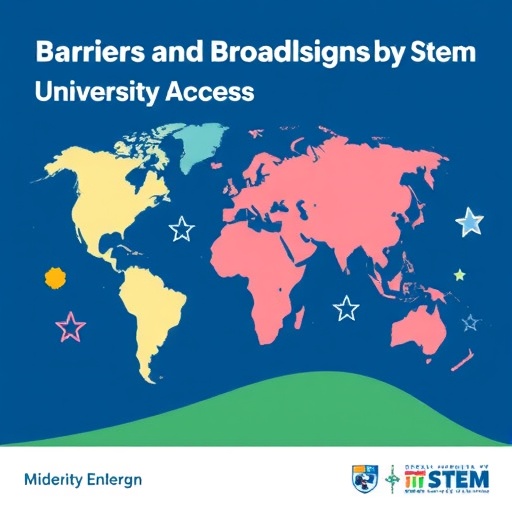In recent years, the call for greater inclusivity and diversity within Science, Technology, Engineering, and Mathematics (STEM) fields has intensified, highlighting a persistent challenge for universities worldwide. Despite numerous initiatives aimed at broadening participation, STEM institutions continue to grapple with entrenched barriers that inhibit equitable access and representation. A groundbreaking systematic literature review by Liu and Kringos (2025), published in IJ STEM Education, delves deep into these global impediments, unearthing complex, multifaceted causes that hinder universities from achieving wider, more inclusive participation.
The comprehensive review synthesizes data from a vast array of international studies, providing an unparalleled overview of the structural, cultural, and pedagogical challenges faced by STEM universities. Central to the findings is the recognition that barriers to participation are not uniform but vary by region, culture, and institutional practices. This nuanced perspective challenges the one-size-fits-all approaches that many diversity initiatives have previously employed, calling for adaptive strategies tailored to specific contexts and student demographics.
One critical revelation of the study is the persistence of implicit biases within admissions processes and classroom dynamics. These biases often manifest subtly but have profound impacts on underrepresented groups, including women, ethnic minorities, and students from low socioeconomic backgrounds. Admission criteria that heavily weigh standardized testing, for instance, frequently overlook talent and potential demonstrated through non-traditional academic paths or experiential learning. This entrenched reliance on conventional benchmarks thus excludes many capable students from entering STEM pipelines.
Furthermore, Liu and Kringos illustrate how institutional cultures within STEM faculties can be unwelcoming or even hostile to marginalized students. The so-called “chilly climate” in STEM environments—characterized by isolation, lack of role models, and implicit stereotyping—exacerbates attrition rates among underrepresented groups. The research points out that retention and success are equally critical as initial access, emphasizing the need for holistic support systems that engage students throughout their academic journey.
Another layer of complexity emerges from structural inequalities outside the university context. Pre-university educational disparities, socio-economic constraints, and limited access to STEM enrichment opportunities create a cumulative disadvantage that universities must reckon with. Liu and Kringos argue that without addressing these foundational inequities, university-led widening participation programs are constrained in scope and effectiveness.
Technological advancements and pedagogical innovations also play a paradoxical role. While digital tools and active learning methodologies promise more personalized and engaging educational experiences, they can inadvertently deepen divides if access is uneven. The review highlights a gap in equitable access to high-speed internet, hardware, and software necessary for modern STEM curricula, disproportionately affecting students from rural or economically disadvantaged areas.
Policy frameworks and funding allocation patterns surface prominently as determinants in shaping participation landscapes. Governments and university administrations that prioritize STEM diversification through substantial resource commitments tend to foster more significant progress. Conversely, fragmented or underfunded initiatives struggle to achieve scale and sustainability. Liu and Kringos suggest that institutional accountability, coupled with transparent metrics for participation and success, is essential for transformational change.
The role of mentorship and community building emerges as a vital protective and empowering factor against attrition. The review identifies programs that connect students with peer networks, faculty mentors, and professional role models as instrumental in fostering a sense of belonging and academic resilience. However, the availability and quality of such mentorship often vary widely between institutions, underscoring the need for systemic integration rather than isolated pilot initiatives.
Liu and Kringos also examine gender-specific challenges, especially in fields like engineering and computer science, where women remain significantly underrepresented. The systemic masculinization of these disciplines, perpetuated by stereotypes and socialization, limits both recruitment and retention. Their review calls for culturally responsive pedagogies and institutional reforms that dismantle gender norms and support women’s full participation.
The intersectionality of identity factors, such as race, gender, and socioeconomic status, receives substantial attention. The authors emphasize that interventions must move beyond single-axis frameworks to address the compounded disadvantages faced by individuals occupying multiple marginalized identities. Intersectional approaches allow for more targeted and effective strategies that acknowledge diverse lived experiences in STEM education.
International comparisons provide valuable contrasts in policy and practice. Some regions have succeeded in widening participation through early outreach, inclusive curricula, and structural reforms, offering transferable lessons. However, the review cautions against wholesale importation of models without contextual adaptation, advocating instead for locally informed innovations grounded in global evidence.
Crucially, the review sheds light on how perceptions of STEM fields themselves influence participation. Public images that portray STEM disciplines as rigid, elitist, and detached from social relevance deter diverse applicants. The authors call for concerted efforts to reframe STEM narratives, highlighting societal impact, collaborative problem-solving, and creative possibilities inherent in these fields.
The systematic approach adopted by Liu and Kringos ensures that their conclusions are robust and empirically grounded, providing a critical resource for policymakers, educators, and institutional leaders committed to inclusivity in STEM. They underscore the urgency of coordinated, long-term efforts that encompass pre-tertiary education, university policies, and broader societal change to enable genuine widening participation.
Ultimately, this review challenges STEM universities to reconceptualize diversity not as an add-on but as a fundamental axis of excellence and innovation. Recognizing and dismantling the barriers preventing broad participation is not just about equity; it is about enriching STEM disciplines with diverse perspectives essential for tackling global challenges.
The research by Liu and Kringos marks a significant milestone in understanding systemic hurdles and opens pathways toward more inclusive and vibrant STEM educational ecosystems. Their evidence-based insights serve as a clarion call to reimagine STEM universities as truly accessible and empowering institutions for all aspiring learners worldwide.
Subject of Research: Barriers to widening participation in STEM universities globally.
Article Title: What prevents STEM universities from widening participation? A systematic literature review on global experiences.
Article References:
Liu, Z., Kringos, N. What prevents STEM universities from widening participation? A systematic literature review on global experiences. IJ STEM Ed 12, 63 (2025). https://doi.org/10.1186/s40594-025-00580-0
Image Credits: AI Generated




